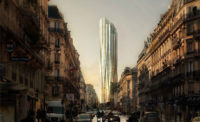Coming to Life
With its infrastructure nearly complete, Ground Zero is rising.
After nine years, Ground Zero is coming to life. If, in the intervening years, we have repressed our memories and ignored actual progress on the benighted 16-acres in Lower Manhattan, we can refamiliarize ourselves with its transformation, for the seemingly impossible is happening.

Of course, they said it couldn’t be done. Conventional wisdom, tongue-waggers, critics of all stripes, and political naysayers have been prognosticating that we would never see the completion of the structures intended for the former World Trade Center site during this decade. So much worked against completion, not least the current economy, with its glut of office space in Manhattan. Yet all, including pundits at architectural record, failed to take New York grit into full account.
The recent solemnities surrounding September 11 brought Arlington, Virginia, and Shanksville, Pennsylvania, but especially Lower Manhattan into focus once again. The media attention reminded us that, not only did this nation and the world suffer grievous harm in the destruction of the lives lost at the World Trade Center, but that the 10th anniversary looms around the corner, with planning and architecture at the forefront of the healing process. We are literally stitching ourselves back together and dreaming again.
Many have lost their bearings since the heady days that Daniel Libeskind took center stage — a period during which everyone seemed to be familiar with the plans and the principal players involved. Today, the overall scheme reflects the chastening and clarity that come from a near-decade of political and social debate as well as the realities of more realistic budgets.
Where are they today? Frank Gehry has completely exited the scene, no longer engaged in an arts center. Libeskind’s overall scheme, animated as it was by a powerful narrative, seems overwhelmed, if not totally lost in the proceedings. Calatrava’s PATH station (now called the Transportation Hub) continues; the Fulton Street Transit Center (Grimshaw Architects and Arup, in collaboration with James Carpenter) has been simplified from the more ambitious original proposals. Snøhetta’s cultural complex has morphed into a different purpose. Michael Arad’s vision for the Memorial Pools remains, if his overall role has changed.
One World Trade Center, owned by the Port Authority of New York and New Jersey, seems to be rushing upward. At 38 stories as of this writing, the structure should reach as high as 90 stories by September of 2011. Designed by Skidmore, Owings & Merrill, the 1,776-foot-high tower (counting its spire) will overtop all other buildings in the United States. The megastructure is moving quickly: To miss a week of construction risks missing change and a few floors. A roster of potential tenants has been issued, including, surprisingly, Condé Nast, the publishing company, as well as governmental agencies such as the U.S. General Services Administration and New York State.
Highly visible, and receiving significant attention, has been the $530 million Memorial Plaza at the center of the site. On receiving the final commission, the memorial’s architect, Arad, was united with the landscape architect, Peter Walker. (Remember the title, Reflecting Absence?) In Walker’s plaza scheme, 416 oak trees will ultimately surround the 8-acre plaza surrounding the memorial. Arad’s concept, replacing the footprints of the twin towers with massive twin waterfalls (touted as the country’s largest engineered waterfalls, with more than 400,000 gallons in circulation), remains. After sometimes-contentious discussion with stakeholders, the memorial will serve as a poetic focal point for the emotions and memories that still hover in this place.
As Libeskind proposed, sections of the slurry wall will remain, visible to public examination. The locus has shifted to the subterranean National September 11 Memorial and Museum designed by Davis Brody Bond Aedas, however. This repository of artifacts from the site, including massive steel members, is complemented by Snøhetta’s aboveground entry pavilion, a refreshing polyhedron that likewise already houses the 70-foot-tall, trident-shaped columns that undergirded the original World Trade Center Towers.
The surprising constant on-site has been the presence of the developer, Larry Silverstein, whose tenacity is resulting in multiple structures, when some thought he might not ride out the economic and popular waves. His 7 World Trade Center, an elegant sheath with stunning views of Lower Manhattan, was the first major structure to be completed on the property. Silverstein’s additional offerings include three buildings: Tower 4, designed by Fumihiko Maki, which is already under construction and may reach a height exceeding 45 stories by next fall; and Towers 2 and 3, by London architects Foster + Partners and Rogers Stirk Harbour + Partners, respectively.
New York’s mayor Michael Bloomberg has matched Silverstein’s tenacity. When the Memorial faced a lackluster fund-raising effort, Bloomberg took the reins as chairman of the National September 11 Memorial and Museum, and the foundation’s fortunes began to rise like the towers. He has subsequently announced that the plaza will be complete for the 10th anniversary, on September 11, 2011.
Will the Sturm und Drang, the passions unleashed, the vagaries of the design and construction process cohere? What of the urbanistic implications or the design qualities of the actual structures? architectural record will continue to follow the progress on the World Trade Center site, as we have for the past decade, and serve as a focal point for opinions and news on this rapidly developing quadrant of the nation’s conscience. Stick with us.
If you wish to write to our editor-in-chief you can email him rivy@mcgraw-hill.com.




